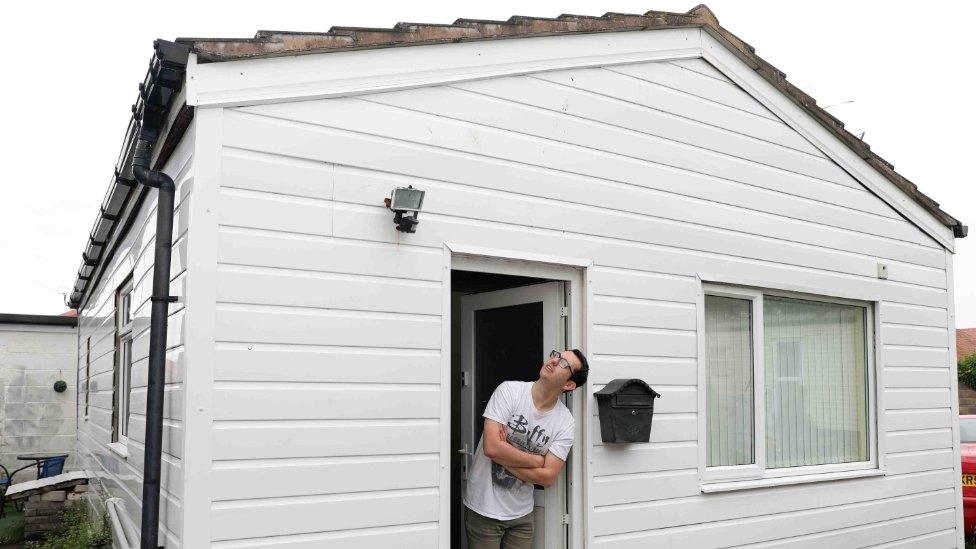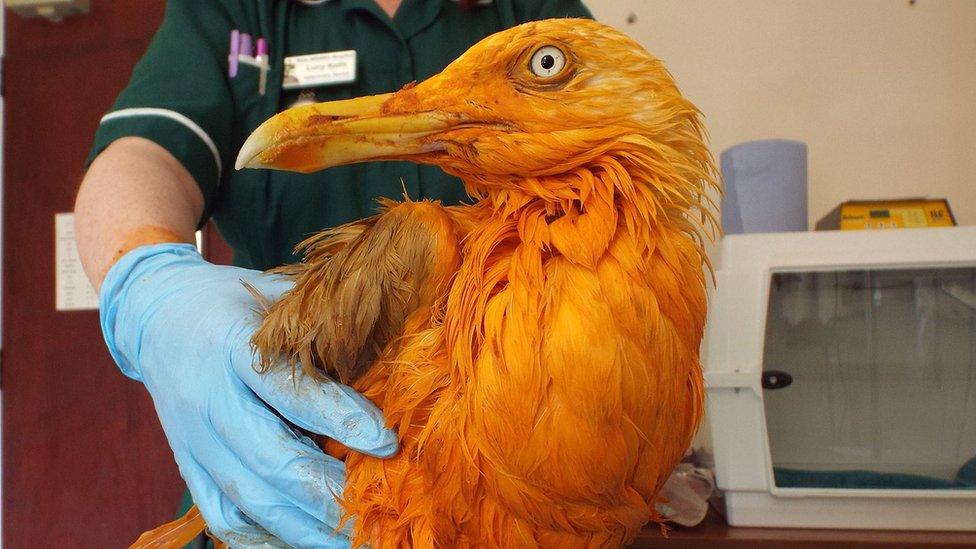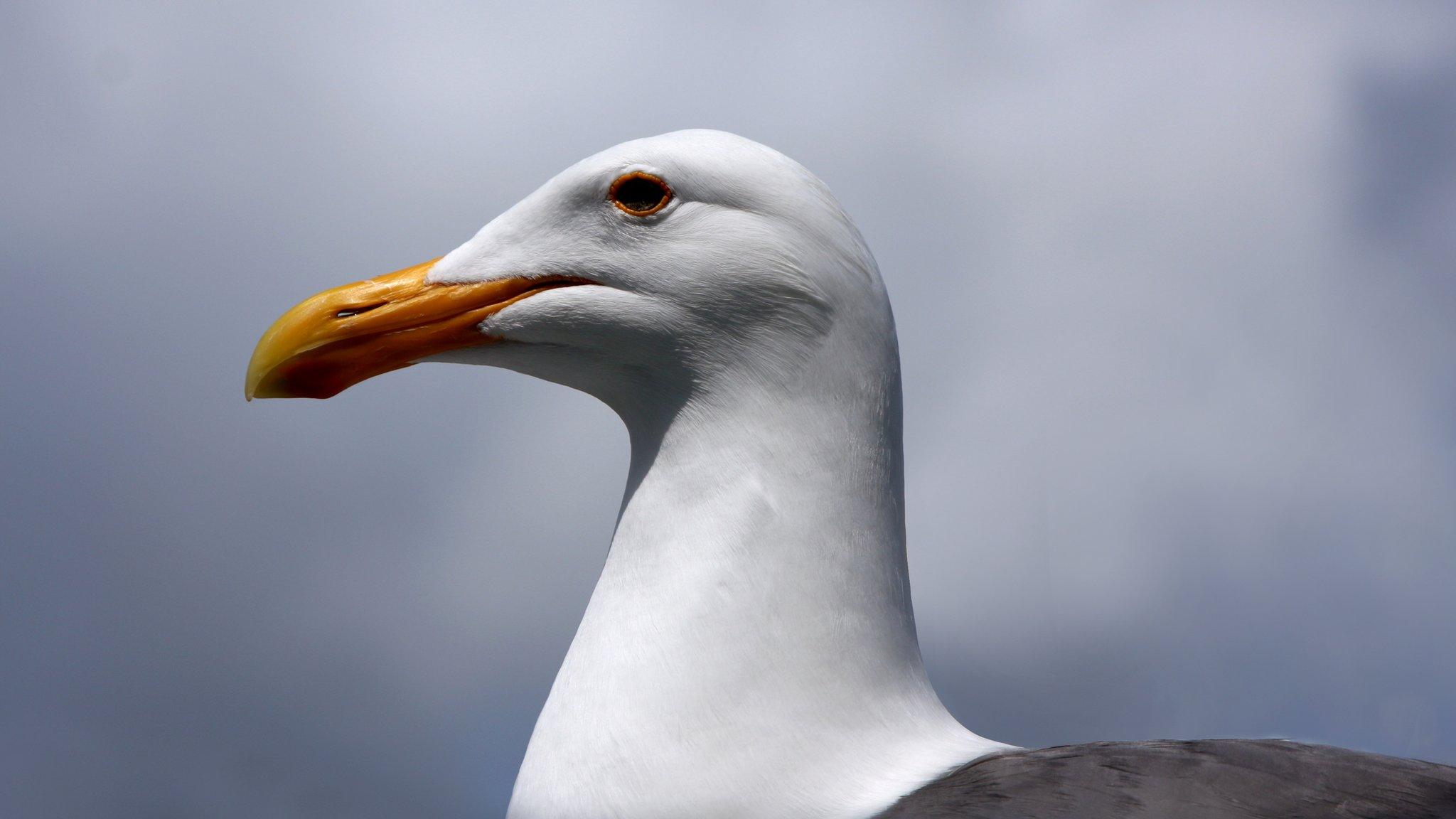Seagull attacks: Does the UK have a problem?
- Published

A family in Devon says a seagull swooped down, grabbed a pet Chihuahua "by the scruff of his neck", and flew off with it.
So are gulls getting more aggressive? And what can be done to stop them? We look at some of the approaches being taken across the UK.
1. Make do and deter
There is an unusual looking aerial poking out of Brian Warry's chimney.
The fridge engineer, 77, has concocted his own plan to get squawking gulls off his roof so that he can get a good night's sleep.
Now, sitting in the bottom of his fireplace in Littlehampton, West Sussex, is one end of a fishing rod - the other is about 40ft up.
"I just thought 'what's the best way to get to them?' Now when I hear gulls I shake the pole in the fireplace - it just unsettles them and they tend to fly away."
A more common weapon of choice is the humble umbrella.
Tom Ellis, 29, from Prestatyn, in Wales, was advised by his local council earlier this month to reach for his brolly to dodge the "vicious" seagulls repeatedly swooping at him from his roof.

Tom Ellis said it was "scary" leaving the house
Mr Ellis said the birds would squawk to "try and intimidate" him.
"A couple of times they have gone for the third swoop to make contact, and I have just about got into the house before they have managed to," he said.
But when he approached his local council, he says he was told "put up an umbrella, there is nothing that you can do."
2. Invest in a gadget
One tourist town has tried a hi-tech approach to the problem.
Local business owners in St Ives, Cornwall, launched a Snapchat Seagull Filter in 2017 which appeared in certain parts of the town with the caption "don't feed the gulls."

This Snapchat filter was only available in parts of St Ives in a bid to discourage visitors from feeding the local gulls
At the other end of the UK, the Old School House pub in Aberdeen was among a number of British businesses to offer customers water pistols to warn off hungry gulls.
The pub says it stopped the practice for the birds' welfare and is now relying on shelter from garden parasols.
Each of the seven different species of gull found in the UK - commonly referred to as seagulls - are of "conservation concern", according to the charity RSPB.
It has "red listed" the herring gull, external due to its declining population. The Mediterranean gull population is the only one not in decline, it says.
But councils and landowners do sometimes apply for a licence from Natural England to take action on "nuisance" birds.
In Worcester, drones are being used to hunt for nests. Once found, pest controllers replace the real eggs with fakes.
How Worcester's drones search out the seagull nests
3. Harness the power of nature
Falcons and hawks are commonly used - including near a primary school in Porthmadog, Gwynedd. The head teacher said playtime had been "quite terrifying" for pupils and so had to take action.
Southern Water have used hawks to try and stop gulls fouling bathing water on a beach on the West Sussex coast.
Gulls see a large bird of prey as a threat, so as soon as they take to the skies, they scatter. Unlike other deterrents that gulls may get used to, a bird of prey will always be a threat.
In other areas, councils have turned to "egg oiling". Removing the eggs from the nest and dipping them in liquid paraffin forms a seal around the egg that stops them from maturing and hatching.
The gulls continue to sit on the eggs until they eventually move on.
4. Tidy up after yourself
While total numbers are declining, you may still be seeing more of them, according to bird experts.
That's because some species have become urbanised and are living closer to humans, says Dr Steve Portugal from the Royal Holloway University of London.
As their natural environments on cliff tops become seaside towns, he says, some species have travelled inland where they find high rooftops as a substitute home and plenty of food from litter and food waste.
"We may think they are increasing in numbers because we see them more, but they have mainly just shifted where they are living," he said.

A seagull in south east Wales turned bright orange after falling into a vat of chicken tikka masala in 2016
5. Move to a position of acceptance
Bird experts say that reports of gull attacks tend to rise when new chicks are born - usually from the end of May until August.
Wildlife expert Charlotte Ambrose, of the RSPB, says most gulls are "caring and attentive parents" who will defend their young from any perceived threats.
"The male helps to incubate the eggs and then later takes it in turns with the female to look after and feed the young chicks," she explained.
"Until they can fly the young are particularly vulnerable so the devoted parent gulls will defend them from anyone who comes too close.
"As a last resort a gull might swoop close to a perceived threat to defend their young if it feels there is no other option, but a physical attack is very rare."
But why would a gull make off with a dog?
"It's quite possible that a fluffy small dog was mistaken for a rabbit - but it is certainly not a common behaviour," Dr Portugal says.
"It might not be that such attacks are increasing but I think these things tend to get picked up much quicker than before."
- Published22 July 2019

- Published27 November 2018
